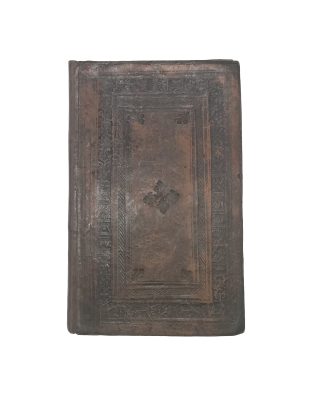ERASMUS
CONTEMPORARY CALF
De duplici copia verborum. [with] De ratione studij aclegendi interpretandisque authores.
Paris, Simon de Colines, 1530£3,250.00
Tall 8vo. 2 works in 1, ff. 137 (xxiii); ff. 31 (i), last blank. Italic letter, little Roman or Greek. Woodcut printer’s device to t-ps, decorated initials and ornaments. First t-p minimally dusty, light age yellowing, a few ll. slightly foxed at margins, small paper flaw to lower outer blank corner of b3 and upper edge of c3, expert repair at foot of c2, touching not affecting two letters and a couple of margins. A very good, clean, well-margined copy in contemporary French calf, period-style reback, outer border with blind roll of urns and tendrils, second with blind hatched roll, central panel with blind-stamped fleurons at corners and composite large fleuron to centre, expert repair to corners and edges, eps renewed (but not modern). Contemporary autograph ‘Claudius Belinus’ to first t-p, ms. note in his hand to second work.
A very good, clean, well-margined copy of this Erasmian sammelband for school use, comprising two of the most influential works in the Renaissance—the second in an edition unknown to Renouard. Erasmus (1466-1536), the greatest humanist and philologist of the northern Renaissance, wrote some of the most important ‘mirrors for princes’ (‘Institutio principis Christianis’, 1516) and educational works for the elites (‘Adagia’, 1500), often acquired and bound together. First published in 1512, ‘De copia’, here in its third Colines edition, was ‘a phenomenally popular treatise of Latin composition’ (Schreiber). Prefaced by a letter to the humanist John Colet, whom Erasmus befriended during his stay in England, ‘De copia’ is a manual of amplification, i.e., alternative ways of expressing the same word or concept. After an initial section on the perils of excessive affectation, it provides examples using rhetorical devices (e.g., metalepsis, synecdoche, allegory), the use of contraries, comparisons, synonyms or periphrasis, or examples such as the use of ‘fabulae’ (myths), with references to ancient authors. Appended are Erasmus’s letters to humanists, including Jakob Wimpheling, on topics including children’s education, with mentions of his journey to Basel and the scholars he met. ‘De ratione’, first published in 1511 and here in the second Colines edition, focuses on children’s humanist education. The first section is devoted to authors that should be taught (especially Quintilian); the second reproduces an oration on Christ the child which Erasmus delivered at John Colet’s school in London (i.e., St Paul’s); the third and fourth a ‘carmen’ spoken by Jesus to mortals and a few more exemplifying different poetic metres. This copy was probably in the library of the young Claude Belin (1510-95), later ‘avocat fiscal’ in Amont. In 1565, he was appointed councillor of the Parliament at Dole, an office facilitated by Cardinal Granvelle, with whom Belin entertained a copious correspondence. In 1588, he published a pamphlet on a parricide which took place in his city (Suchaux, I, 32). A lovely copy, in an interesting provincial French binding.
I: Schreiber, 58; Renouard 153-4. Not in BM STC Fr. II: Schreiber, 59: ‘unknown to Renouard’. Not in Renouard or BM STC Fr. Galerie biographique du département de la Haute-Saône (1864), I.In stock








